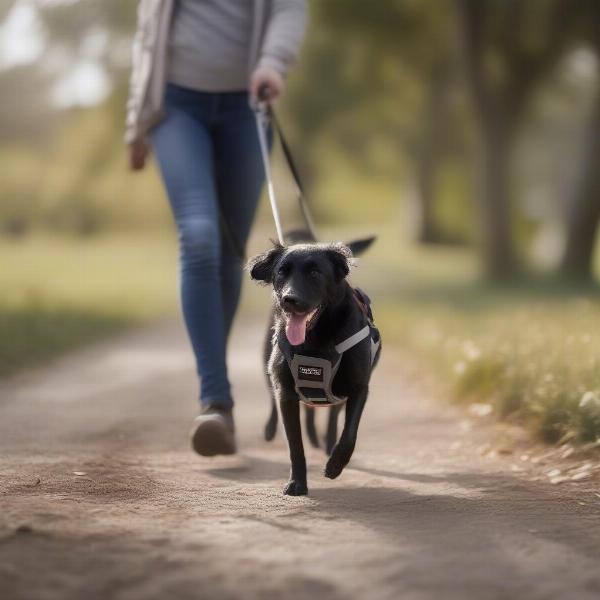Adopting a blind dog can be an incredibly rewarding experience. While it may seem daunting at first, with the right approach and a little patience, you can provide a blind dog with a happy, fulfilling life. This guide offers practical advice and expert insights into caring for a sightless companion, from adapting your home to enriching their environment. Understanding their unique needs will empower you to give a deserving dog a second chance at happiness.
Understanding a Blind Dog’s Needs
Blind dogs, much like humans, rely on their other senses to navigate the world. Their senses of smell, hearing, and touch become heightened, allowing them to adapt surprisingly well to their lack of sight. However, they do require some specific considerations to ensure their safety and well-being.
Creating a Safe Haven
The key to helping a blind dog settle in is creating a consistent and predictable environment. Avoid rearranging furniture frequently, as this can disorient them. Use scent markers, such as essential oils (safe for dogs!), near their food and water bowls and bed. This creates a “scent map” that helps them navigate.
Communication is Key
Verbal cues become crucial with a blind dog. Use clear and consistent commands for actions like “sit,” “stay,” and “come.” Pair these commands with a gentle touch initially, so they associate the word with the action. Praise and rewards are essential for positive reinforcement.
Enrichment Activities
While they can’t see, blind dogs still need mental and physical stimulation. Puzzle toys that dispense treats engage their sense of smell and problem-solving abilities. Short, frequent walks in familiar areas provide physical exercise and opportunities to explore using their other senses.
Adapting Your Home for a Blind Dog
Simple modifications can make your home safer and more comfortable for a blind dog. Use baby gates to block off stairs or other hazardous areas. Pad sharp corners of furniture with foam or pool noodles. Keep hallways clear of obstacles, and maintain a consistent layout to minimize confusion.
Introducing a Blind Dog to Other Pets
If you have other pets, introduce them to your blind dog gradually and under supervision. Allow them to sniff each other through a barrier initially, then supervised short interactions. This helps minimize stress and allows them to adjust to each other’s presence peacefully.
Navigating Outdoors
When walking your blind dog, consider using a harness instead of a collar for better control and comfort. Keep them on a leash at all times in unfamiliar areas. Talk to them frequently during walks to reassure them and describe the environment.
 Walking a Blind Dog Safely with a Harness
Walking a Blind Dog Safely with a Harness
Nutrition and Health Considerations for Blind Dogs
A balanced diet is crucial for any dog, but especially for blind dogs who rely heavily on their other senses. Choose high-quality dog food appropriate for their age and breed. Maintain a consistent feeding schedule and location to provide predictability. Regular veterinary checkups are essential to monitor their overall health and address any specific needs related to their blindness.
Expert Insights on Blind Dog Care
Dr. Emily Carter, a veterinary ophthalmologist, emphasizes the importance of early intervention in cases of progressive blindness. “Early diagnosis and treatment can sometimes slow down the progression of certain eye conditions and help preserve some vision. Regular eye exams are crucial for all dogs, but even more so for those exhibiting signs of vision impairment.”
Furthermore, Sarah Miller, a certified dog trainer, advises, “Patience and positive reinforcement are key when training a blind dog. Focus on building their confidence and trust through consistent commands and rewards. They are incredibly adaptable and can learn new skills just as effectively as sighted dogs.”
Conclusion
Giving a blind dog a second chance requires understanding, patience, and a little adaptation. By creating a safe and stimulating environment, communicating clearly, and providing consistent care, you can help a sightless companion thrive and live a full and happy life. Remember, the love and companionship you receive in return will be immeasurable.
FAQ
- Can blind dogs still play fetch? Yes! Use toys that make noise, such as squeaky balls, so your dog can track them by sound.
- How do I know if my dog is going blind? Signs include bumping into objects, hesitancy in new environments, and cloudy eyes. Consult your veterinarian for diagnosis.
- Are certain breeds more prone to blindness? Yes, some breeds have a higher predisposition to certain eye conditions that can lead to blindness.
- Can blind dogs live happily with other pets? Absolutely! With proper introduction and supervision, blind dogs can coexist peacefully and even form strong bonds with other animals.
- Do blind dogs need special food? Not necessarily, but a balanced diet is crucial for their overall health and well-being.
- How can I make my home safer for a blind dog? Use baby gates, pad sharp corners, and maintain a consistent furniture arrangement.
- Can blind dogs go for walks? Yes, regular walks are important for physical exercise and mental stimulation. Use a harness and leash and talk to them frequently to describe the environment.
Related Articles
About ILM Dog
ILM Dog is your trusted international resource for comprehensive dog care information, covering everything from breed selection and health to training and nutrition. We are dedicated to providing practical advice and expert insights to help dog owners worldwide give their furry companions the best possible care. For expert advice on dog health, training, nutrition, and more, contact us at [email protected] or call us at +44 20-3965-8624.